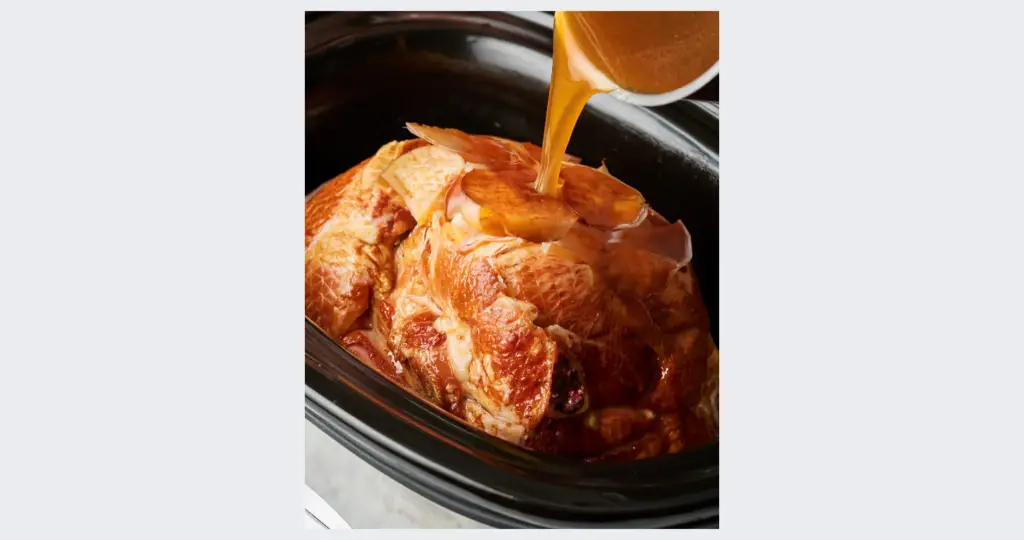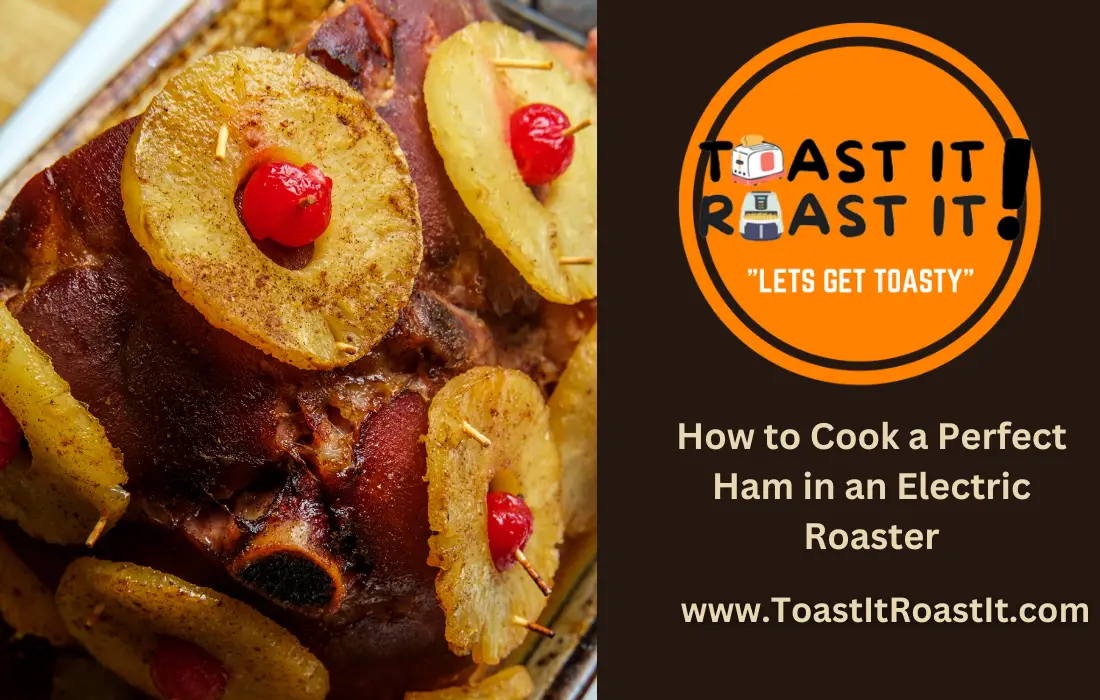Whether you’re a novice in the kitchen or a seasoned cook, preparing a juicy, tender ham in an electric roaster is an adventure worth embarking upon. I took this journey for a work Christmas party, and trust me, the outcome was nothing short of spectacular. With the right ingredients, precise timing, and an electric roaster at your disposal, you’re set for a culinary delight that will surely impress.
To cook a perfect ham in an electric roaster, first preheat your roaster to 325°F. Place your ham in the roaster and cover it. Cook the ham for about 20 minutes per pound, or until its internal temperature reads 140°F on a meat thermometer.
In this comprehensive guide, we will delve into the succulent world of ham roasting, specifically focusing on the usage of an electric roaster. As we navigate through the process, we will equip you with expert tips, answer relevant queries, and unveil the magic behind a perfectly roasted ham, ready to grace your family dinners or festive celebrations. So, embark on this flavorful journey with us, because if it tastes good, it’s good!
- Why Choose an Electric Roaster for Your Ham?
- Electric Roaster vs. Conventional Oven
- Choosing Your Ham and Preparing It for Roasting
- The Recipe: Roasting Your Ham to Perfection
- Roasting Time and Temperature
- Roasting Time and Temperature by Weight of Ham
- Cleaning and Maintenance of Your Electric Roaster
- Frequently Asked Questions (FAQ)
- Conclusion
Why Choose an Electric Roaster for Your Ham?
When it comes to roasting a ham, many might instinctively reach for their traditional oven. However, the electric roaster offers a set of benefits that can take your cooking experience to new heights.
Firstly, electric roasters are incredibly efficient. They heat up quickly and maintain a consistent temperature throughout the cooking process. This even, steady heat results in a ham that’s beautifully roasted and evenly cooked. No more worries about hot spots or uneven browning that you might face with a conventional oven.

Additionally, electric roasters are exceptionally energy efficient. Unlike conventional ovens that heat up your entire kitchen, electric roasters keep the heat confined within the appliance. This means less energy used, and during those hot summer months, a cooler kitchen.
Finally, electric roasters free up oven space. This can be particularly useful during holiday cooking marathons when oven real estate is at a premium. With your ham comfortably roasting away in the electric roaster, your oven is free for baking those pies and casseroles.
From my personal experience, once you taste a ham slow-roasted in an electric roaster, you’ll be hard-pressed to return to conventional oven roasting. The end result is a succulent, juicy ham with a deliciously crispy exterior, cooked to perfection without fuss or bother. It’s efficient, practical, and above all, tasty! Trust me, your taste buds will thank you.
Electric Roaster vs. Conventional Oven
When it comes to cooking a ham, the battle between the electric roaster and the conventional oven is a tasty one. Let’s explore the differences, shall we?
Electric Roaster:
- Efficiency: Electric roasters heat up quickly and maintain a consistent temperature, making them quite energy efficient. Great for the multitasker in you!
- Portability: Hosting a BBQ party? You can easily take an electric roaster outdoors (weather permitting, of course).
- Space-Saver: Ideal for those with limited oven space, especially during the holidays. Your turkey can roast in the oven while your ham roasts in the electric roaster.
- Moisture Retention: Generally speaking, electric roasters are designed to keep the moisture locked in, ensuring a juicy, succulent ham.

Conventional Oven:
- Versatility: An oven can handle a broader range of cooking methods. You can bake, broil, roast – the world is your culinary oyster.
- Capacity: Depending on the size, a conventional oven might allow you to cook multiple dishes simultaneously.
- Temperature Control: While this can vary between models, high-end ovens often provide precise temperature control.
Comparison Table:
| Feature | Electric Roaster | Conventional Oven |
|---|---|---|
| Efficiency | High | Varies |
| Portability | Yes | No |
| Space-Saving | Yes | No |
| Moisture Retention | Excellent | Good |
| Versatility | Good for roasting | Excellent for all methods |
| Capacity | Generally smaller | Larger |
The Verdict:
Choosing between an electric roaster and a conventional oven depends on your specific needs and preferences. If portability, efficiency, and moisture retention are high on your priority list, an electric roaster may be the way to go. On the other hand, if you value versatility and have the space for a larger capacity, a conventional oven might be your best bet.
Choosing Your Ham and Preparing It for Roasting
Now that we’ve decided on using the electric roaster, let’s talk about the star of the show – the ham. When selecting a ham for roasting, consider a pre-cooked ham, also known as a city ham. These hams are typically wet-cured and come fully cooked, making them an ideal choice for your electric roaster. They tend to be moister and sweeter than other types of ham, perfect for those of us with a sweet tooth. Plus, their large size and bone-in structure can make quite the statement at your dinner table!

Now, onto the flavor. Ham is naturally flavorful, but a little extra seasoning can go a long way in enhancing its taste. Here are five tips on how to add flavor to your ham in an electric roaster:
- Glaze it: A sweet or savory glaze can work wonders on your ham. Honey, brown sugar, and maple syrup are all excellent choices for a sweet glaze. For a savory kick, consider mustard or soy sauce.
- Spice it up: Don’t shy away from using spices. Cloves, cinnamon, and nutmeg can impart a wonderful aroma and depth of flavor to your ham.
- Add fruit: Fruits such as pineapple, cherries, or oranges not only add flavor but also make for an appealing presentation.
- Inject it: For flavor throughout, consider injecting your ham with a marinade. This can be as simple as a mixture of apple juice, brown sugar, and your favorite spices.
- Score it: Before applying your glaze or spices, score the surface of the ham. This allows the flavors to penetrate deeper, making every bite a flavor explosion.
With these tips, you’ll have a ham that’s not only roasted to perfection but also brimming with mouthwatering flavor. Now, let’s get to roasting!
The Recipe: Roasting Your Ham to Perfection
Alright, folks, we’ve selected our ham, added some flavors that would make any foodie swoon, and now it’s showtime. Let’s embark on our ham-roasting adventure in the electric roaster.
- Preheating: First things first, let’s preheat that roaster. Set your electric roaster to 325°F and let it warm up while you prepare your ham. No one likes a cold welcome, especially our soon-to-be-roasted ham.
- Score the Ham: Remember when we talked about scoring the ham earlier? Now’s the time to do it. Grab a sharp knife and make diagonal cuts across the ham about an inch apart. Make sure not to cut too deep, about 1/4 inch is just right.
- Add Flavor: Brush your chosen glaze or seasoning all over the ham, taking care to get it into the scores for maximum flavor. Don’t be stingy, it’s a party for your ham, and flavor is the guest of honor.
- Roast: Place your ham in the roaster, cover it up and let the magic happen. Remember, it’s a slow dance, not a quick tango. You’re looking at about 20 minutes per pound of ham. So, sit back, relax, and let the roaster do the work.
- Check Temperature: After the required cooking time, check your ham’s temperature with a meat thermometer. You’re aiming for an internal temperature of 140°F.
- Rest and Carve: Finally, remove your ham from the roaster and let it rest for 15 minutes before carving. This allows the juices to redistribute, resulting in a more tender and juicy ham.
As a chef who’s roasted his fair share of hams, here’s a golden nugget of advice: patience is key. Unlike using a conventional oven where you might be tempted to peek and poke, resist the urge with an electric roaster. Every time you lift that lid, you’re letting out heat and interrupting the cooking process. Trust the process, follow the steps, and you’ll be rewarded with a ham that’s worthy of the holiday centerpiece.

Honey Glazed Ham and Pineapples Recipe
There’s something magical about the combination of sweet honey glaze, juicy ham, and tangy pineapples. It’s like a culinary symphony playing in your mouth! This Honey Glazed Ham and Pineapples recipe is sure to hit all the right notes at your next gathering.
- Total Time: 1 hours 15 minutes
- Yield: 10–12 servings 1x
Ingredients
- 1 (8-10 lb) pre-cooked ham
- 1 cup honey
- 1/2 cup brown sugar
- 1/4 cup Dijon mustard
- 1 (20 oz) can pineapple rings, drained
- 10 whole cloves
- Salt and pepper to taste
Instructions
- Preheat your electric roaster to 325°F.
- Mix honey, brown sugar, mustard, salt, and pepper together to form the glaze.
- Place ham in the roaster, fat side up, and score the surface in a diamond pattern.
- Stud ham with cloves at the intersections of the cuts.
- Brush half of the glaze over the ham.
- Arrange pineapple rings over the top, securing with toothpicks.
- Roast for 1 hour, basting with remaining glaze every 20 minutes.
- Cook until ham reaches an internal temperature of 140°F.
- Allow to rest for 15 minutes, then carve and serve.
Notes
- Feel free to add maraschino cherries for a colorful touch.
- Basting frequently will ensure a rich and flavorful crust.
- Prep Time: 15 minutes
- Cook Time: 1 hour
- Category: Main Course
- Method: Slow Cooking
- Cuisine: American
Roasting Time and Temperature
While the excitement of cooking your ham is understandable, it’s essential to remember that a perfectly roasted ham is all about timing and temperature. Let’s delve into the specifics.
As a general rule of thumb, for a pre-cooked ham, aim for a cooking time of about 20 minutes per pound. This guideline applies when you roast your ham at 325°F, which is the ideal temperature for achieving a succulent, juicy ham with a perfectly crisp exterior.
So, let’s answer that burning question – “How long to cook ham in an electric roaster?”
Well, if you’re roasting a 10-pound ham, for example, you’d calculate 20 minutes x 10 pounds = 200 minutes, or roughly 3 hours and 20 minutes. Now, remember, this is a guideline, not a hard and fast rule. Factors such as the shape and size of your ham, how cold it was going into the roaster, and even the brand of your roaster can affect the cooking time.
To ensure your ham is perfectly cooked, I recommend investing in a good meat thermometer. The internal temperature is what really counts. Once your thermometer reads 140°F at the thickest part of the ham (make sure it’s not touching the bone), you’re good to go.
So, while the anticipation of that first bite of tender, juicy ham is exciting, patience and precision are your best friends in this roasting journey. Follow the time and temperature guidelines, use your meat thermometer, and you’re on your way to a perfectly roasted ham.

Roasting Time and Temperature by Weight of Ham
When it comes to roasting ham, knowing the right time and temperature is essential for achieving that perfect, juicy result. Cooking too long or too hot can dry out the meat, while not cooking enough might leave the center underdone. Here’s where I bring in my years of roasting expertise to provide you with a handy guide for roasting your ham based on its weight.
Keep in mind that these guidelines are for pre-cooked hams. Adjustments might be needed if you are cooking a fresh or partially cooked ham.
Explanation:
The roasting time for ham depends on its weight, the type (bone-in or boneless), and whether it’s fully cooked or partially cooked. The temperature should generally be consistent, but the time will vary.
Table: Roasting Time and Temperature by Weight of Ham
| Weight of Ham | Temperature | Time for Fully Cooked (Bone-in) | Time for Fully Cooked (Boneless) |
|---|---|---|---|
| 4-6 lbs | 325°F (163°C) | 1 to 1.5 hours | 1 to 1.25 hours |
| 6-8 lbs | 325°F (163°C) | 1.5 to 2 hours | 1.25 to 1.5 hours |
| 8-10 lbs | 325°F (163°C) | 2 to 2.5 hours | 1.5 to 2 hours |
| 10-12 lbs | 325°F (163°C) | 2.5 to 3 hours | 2 to 2.5 hours |
| 12-14 lbs | 325°F (163°C) | 3 to 3.5 hours | 2.5 to 3 hours |
Note:
- If your ham is only partially cooked, you may need to add extra time to the guidelines above.
- Baste the ham occasionally with its juices or your chosen glaze to ensure a moist result.
- Always use a meat thermometer to verify that the internal temperature reaches 140°F for fully cooked ham or 160°F for partially cooked ham.
Whether you’re cooking for two or feeding a crowd, following these guidelines will help ensure that your ham is cooked to perfection. Remember, every oven and roaster is a bit different, so these times might need a slight adjustment based on your specific equipment. Happy roasting, and as always, if it tastes good, it’s good!
Pairing Your Roasted Ham with the Perfect Beverage
After all this roasting business, I bet you’re getting thirsty. Well, you’re in luck, because a delectable ham pairs beautifully with a variety of beverages. While you have a plethora of options, let’s focus on my personal favorite – red wine.
A medium-bodied red wine, such as a Pinot Noir, complements the rich, smoky flavors of the ham without overpowering it. If you prefer something on the sweeter side, a chilled glass of Riesling might be your best bet. This sweet, slightly acidic white wine pairs delightfully with the salty-sweet taste of ham.
Remember, the perfect pairing is one that you enjoy. So feel free to experiment with different beverages until you find your ideal match. After all, there’s no harm in taste-testing a few glasses of wine, right?

Cleaning and Maintenance of Your Electric Roaster
After enjoying that sumptuous ham and the perfect wine pairing, it’s time to tackle the less glamorous part – cleaning your electric roaster. While it might be tempting to neglect this step, proper cleaning and maintenance can significantly extend the lifespan of your roaster. Plus, nobody wants the taste of their next roast to be marred by the remnants of the previous one.
Here are a few tips on cleaning and storing your electric roaster:
- Cool it down: Before you start cleaning, ensure your roaster is completely cooled down. Hot surfaces and soap are not a good mix, and you definitely don’t want to burn yourself.
- Wipe it clean: Using a damp cloth, wipe down the interior and exterior of the roaster. For stubborn stains, a mild detergent should do the trick. Avoid using abrasive cleaners or scouring pads as they can damage the roaster’s surface.
- Dry it well: After cleaning, make sure to thoroughly dry your roaster before storing it. Any residual moisture can lead to mildew or rust.
- Store it properly: If your roaster came with a box, it’s best to store it in there. If not, a cool, dry place will do.
Remember, a well-maintained roaster is a happy roaster. And a happy roaster means more delicious roasts for you to enjoy. So, embrace the cleaning and treat your roaster with the care it deserves. You’ll thank me for it later!
Frequently Asked Questions (FAQ)
Got some lingering questions about roasting ham in that nifty electric roaster of yours? Fear not, my culinary compadres, for I’m here to clear up those burning queries with a sprinkle of humor and a dash of wisdom.
Can I cook multiple hams at once in an electric roaster?
Absolutely! But, it’s like trying to dance the cha-cha in a packed elevator; you need to make sure there’s enough space. If they fit without touching, you’re golden. Just keep an eye on the cooking time; it might take a bit longer.
How do I reheat leftover ham in the electric roaster?
You mean there was leftover ham? Well, color me surprised! Just set your roaster to 275°F, cover the ham with foil to keep it moist, and heat it for about 10 minutes per pound. Voila, second-day ham that’s just as tasty.
Can I roast other meats in my electric roaster?
Why, yes, you can! Think of your electric roaster as a mini-oven that’s not just for hams. Chickens, turkeys, roasts – go wild, my friend. The world of roasting is your oyster.
How do I avoid drying out my ham in the electric roaster?
Oh, the dreaded dry ham. Fear not! Keep that roaster lid on, baste your ham now and then, and don’t overcook it. Your meat thermometer is your ally in the quest for juicy perfection.
Can I use my electric roaster outside, like for a BBQ party?
While your roaster may enjoy a bit of fresh air, make sure it’s in a covered area and away from the elements. Electric roasters and rain are not the best of friends.
Remember, friends, the path to roasting enlightenment is laden with questions, and that’s okay. Happy roasting, and may your hams be forever juicy and your wines forever flowing!
Conclusion
Well, folks, we’ve taken a tasty journey through the ins and outs of cooking ham in an electric roaster. From selecting the perfect cut to pairing it with a delightful beverage, we’ve covered all the bases.
Now, it’s your turn to take the helm and steer your way through the culinary seas. Whether you’re a seasoned ham-roasting veteran or a curious newcomer, this guide has something for everyone. Trust me; I’ve been around the kitchen block a few times.
Remember, cooking is not just about following a recipe; it’s about the joy of creation, the thrill of experimentation, and the satisfaction of sharing a meal with those you love. Embrace the process, have fun with it, and don’t be afraid to add your unique twist.
I’d love to hear about your roasting adventures. Did your ham make people swoon at the dinner table? Did you discover a new favorite wine pairing? Or perhaps you’ve found a new cleaning trick for that roaster of yours. Whatever it is, feel free to share your stories and tips.
So, grab that roaster, don your apron, and let’s make some delicious memories together. Toasted and roasted food is what it’s all about. Happy cooking, and may your kitchen be forever filled with the sweet aromas of success!


